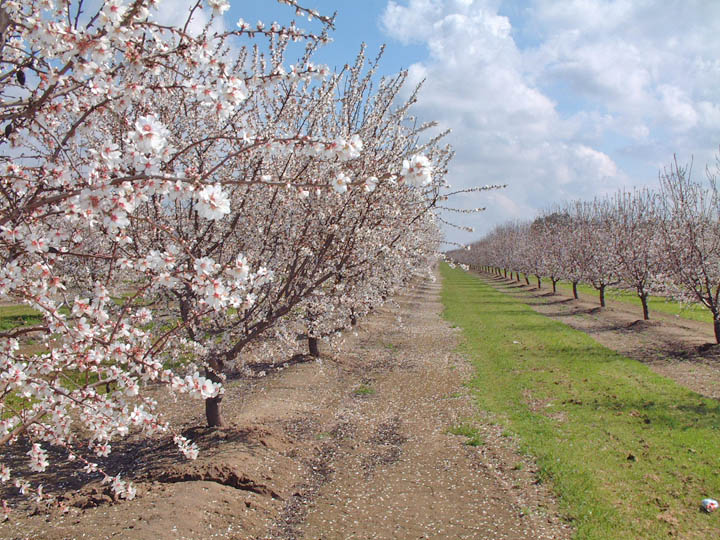February 4, 2014

Band canker
Confirmed band canker infections are on the rise in California Almonds in recent years and can be particularly damaging to 1- to 5-year-old trees. While there is no known chemical cure, growers can take steps to protect young trees from infection through cultural practices.
Canker is a disease caused by eight species of Botryosphaeria that infect young trees under 5 years old through pruning wounds and growth cracks. Infections can also be caused by shaker injury or wind cracks at the base of scaffolds, which can cause them to break.
UC plant pathologist Themis Michailides says growers should check orchards for signs of infection. Blackened gumming on trunks indicates previous infections of canker, while new infections will produce amber-colored balls of gumming in trunks or scaffolds of trees.
Michailides said since there are no chemical controls for canker, focus should be on preventing infections from starting, and when you see signs of infection, removing infected limbs. A simple prevention strategy in young orchards is to make sure sprinklers do not wet trunks of trees.
“If you have sprinklers, installing a splitter that prevents wetting trunks can reduce infection by 50%,” Michailides said. “Infected limbs should be removed, and when you decide to remove an infected tree, you should remove the entire tree; don’t leave stumps or diseased wood in the orchard, as these are a source of spore inocula.”
He also recommends avoiding shaker wounds and pruning when conditions are dry, and avoiding pruning near a rain event. Disease occurs more near riparian areas such as rivers, canals and sloughs. Pruning here first provides an opportunity to spot initial infections.
Generally, Michailides said, when canker infections appear in the trunk of 1- to 5-year-old trees, the tree has a 50-50 chance of survival. If the foliage of an infected tree looks green and healthy, the tree will survive; if the foliage looks chlorotic, it is likely the tree will not survive. Growers will have to decide whether to remove the infected tree or wait and see.
Bacterial spot
Bacterial spot
Bacterial spot, caused by a bacterium (Xanthomonas arboricola pv. pruni), is another spring disease showing up with a high incidence in many California Almond orchards. Last year, the disease created a critical situation in some orchards in Colusa, Merced, Stanislaus and San Joaquin Counties, leading to significant fruit loss.
The Fritz variety of almonds is very susceptible, but isolations have been made on a number of other varieties, which are not as severely affected. A high degree of wetness from rainfall or sprinkler irrigation is favorable for infections. In-season symptoms include numerous fruit lesions that develop amber gumming and result in excessive fruit drop. Leaf spots and defoliation are also symptoms of the disease.
February is a good time to observe if the disease was present in orchards last year. Look for infections on blossoms. Unusual lesions on blossoms can be attributed to several things, but if brown rot sprays have been made and there are still unusual lesions, contact your local farm advisor.
Symptoms of the disease from the previous season can also be found as raised, circular bumps on fruit mummies still attached to the tree. These lesions have high levels of the pathogenic bacterium; in fact, mummy sanitation is a key component of control. Twig lesions and contaminated buds are also overwintering sites.
UC plant pathologists Jim Adaskaveg and Themis Michailides and UC farm advisors Brent Holtz (San Joaquin), David Doll (Merced) and Roger Duncan (Stanislaus) have done much to characterize the extent and nature of this disease in California Almonds; however, management strategies used on other crops in some areas of the U.S., as well as on almonds in Australia, need to be investigated and adapted for California.
UC Riverside plant pathologist Adaskaveg is leading Almond Board–funded research investigating dormant and springtime applications with bactericides. This work should soon offer California-specific recommendations, but for now, UC personnel are basing their advice on experiences in Australia, where bacterial spot was first confirmed in 1994–95, and on information from stone fruit crops in the southeastern United States, where the disease has been endemic for many years.
As this is a relatively new, emerging disease, questions should be directed to UC farm advisors.
Brown rot
With the broad efficacy and reachback of today’s fungicides, growers can hold off on brown rot bloom sprays until full bloom in drier weather, and get by with a single — or perhaps no application — depending on weather conditions and location.
Delaying fungicide treatments to when 40% to 80% of the flowers are open under drier conditions can save on fungicide applications and also help reduce exposure to foraging bees during pollination, while still getting excellent brown rot blossom blight control and coverage for other spring diseases, says Adaskaveg.
Growers can minimize exposure of bees and pollen to sprays by avoiding applications when pollen is available and bees are foraging. This normally is best accomplished by spraying after mid-afternoon and at night.
“We have reviewed fungicide efficacy data, and with today’s efficacy in both pre- and post-infection activity, we can be more discriminatory about our applications,” Adaskaveg said. “If rain is not in the forecast, you can hold off on your sprays until 40% to 80% bloom in the northern part of the state, and get by with a single spray, and in the south, get by with perhaps no spray at all.”
Adaskaveg said that given the excellent efficacy of today’s fungicides, recommendations are moving away from an early pink-bud application at 5% bloom toward a delayed single application under less favorable conditions for disease.
More from Western Farm Press
Top 10 agricultural law developments of 2013
Organic rant from unhappy reader; musings from corporate-funded editor
About the Author(s)
You May Also Like




